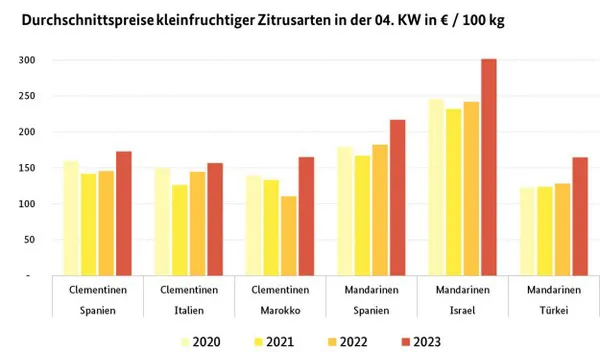Mandarins now prevailed: In particular, Spanish Nadorcott, Tango and Clemenvilla could be accessed. In terms of importance, Israeli imports followed, especially Orri. Turkish and Moroccan articles completed the scene, Italian and Egyptian rounded it off. In Frankfurt, as in the previous week, it was possible to access the newer Queen Selection® variety from Spain. It is quite convincing, with an excellent taste, uniform grading and good peelability. 
In the case of clementines, mainly Spanish shipments came in. However, they had noticeably reduced, as had Italian, Moroccan and Turkish deliveries. Satsumas disappeared completely from the markets. Overall, demand was not particularly strong. It was generally met without difficulty. The very abundant assortment in some places necessitated discounts now and then, if surpluses were to be avoided. It goes without saying that organoleptically less than perfect products also became cheaper, especially clementines. However, price increases were also observed in certain areas.
Apples
Domestic batches still obviously dominated the supply. The quality was often quite convincing, so that traders rarely had reason to modify their previous demands. Constant prices were mostly recorded for Italian lots as well. In Frankfurt, Ambrosia joined the range of goods.
Pears
Italian Abate Fetel, Santa Maria and Williams Christ, together with Turkish Santa Maria, formed the basis of the range. From the Netherlands and inland, Conference and Xenia were the main products. In Frankfurt, local Countess Gepa appeared: The yellow-red fruits were to cost €1.40 per kg.
Table grapes
South African imports dominated the scene. Peruvian and Namibian deliveries played a much smaller role. Thanks to improved accommodation facilities, traders were able to adjust their prices upwards on various occasions. Bright seedless fruits were most popular with customers, which is why they increased in price from time to time.
Oranges
Among Spanish offers, Naval gained relevance, while Navelina lost importance. Salustiana and Lane Late were also increasingly popular. From Turkey, Navel was predominant. Morocco and Egypt mainly participated with Salustiana.
Lemons
Spanish deliveries dominated over Turkish goods. Italian shipments were exclusively in Cologne and Frankfurt. Prices did not change significantly, as supply and demand were sufficiently balanced. Only minor price fluctuations were observed.
Bananas
Marketing was relatively unexciting. However, prices varied, mostly shifting upward slightly. However, there were also price reductions. However, no clear trend was discernible.
Cauliflower
Italian offers predominated. French and Spanish batches had at most a supplementary character. The availability obviously dropped, in some cases very massively. One reason for this was unfavorable weather conditions in the growing regions, resulting in a smaller harvest.
Lettuce
Iceberg lettuce continued to come exclusively from Spain. Returns from food retailers and diverging quality resulted in a wide price range in some cases. Price drops intended to accelerate sales locally. Lettuce was supplied from Belgium, Italy, France and the Netherlands. Sales facilities had improved.
Cucumbers
Spanish cucumbers obviously dominated the markets. Moroccan and Greek goods supplemented this on a small scale, playing a role only selectively. The prices mostly showed a slight downward trend. Locally, prices picked up a bit towards the weekend.
Tomatoes
A diverse and wide-ranging assortment was available. Turkish and Italian deliveries had increased, while Spanish and Moroccan shipments were somewhat limited. Inflows from the Netherlands and Belgium had a complementary status. Demand was quite friendly and could be satisfied in most cases.
Sweet peppers
Spanish arrivals dominated the scene throughout, flanked by Turkish imports. Moroccan and Italian batches were at best of a supplementary nature. Availability was continuously tight and had once again narrowed, especially regarding yellows. Thus, in most cases, prices were able to maintain their high levels of previous weeks.
Source: BLE
